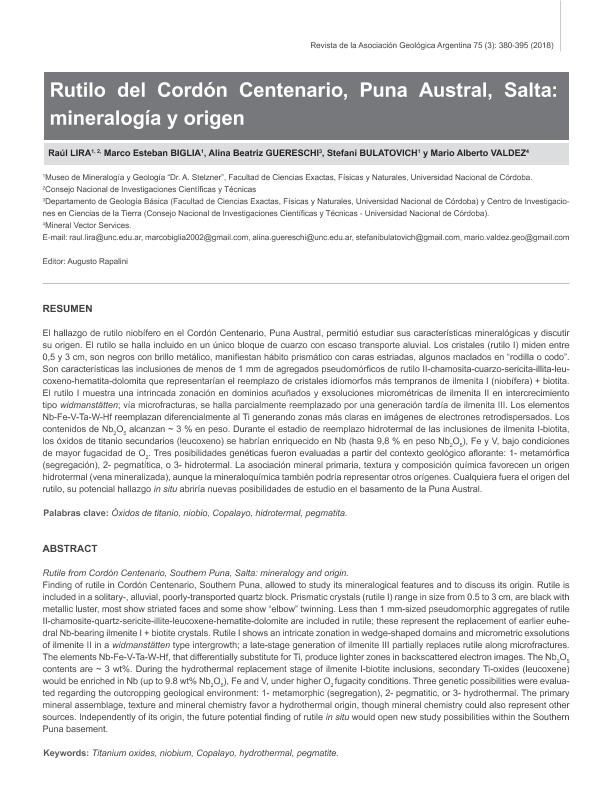Artículo
El hallazgo de rutilo niobífero en el Cordón Centenario, Puna Austral, permitió estudiar sus características mineralógicas y discutir su origen. El rutilo se halla incluido en un único bloque de cuarzo con escaso transporte aluvial. Los cristales (rutilo I) miden entre 0,5 y 3 cm, son negros con brillo metálico, manifiestan hábito prismático con caras estriadas, algunos maclados en “rodilla o codo”. Son características las inclusiones de menos de 1 mm de agregados pseudomórficos de rutilo II-chamosita-cuarzo-sericita-illita-leucoxeno- hematita-dolomita que representarían el reemplazo de cristales idiomorfos más tempranos de ilmenita I (niobífera) + biotita. El rutilo I muestra una intrincada zonación en dominios acuñados y exsoluciones micrométricas de ilmenita II en intercrecimiento tipo widmanstätten; vía microfracturas, se halla parcialmente reemplazado por una generación tardía de ilmenita III. Los elementos Nb-Fe-V-Ta-W-Hf reemplazan diferencialmente al Ti generando zonas más claras en imágenes de electrones retrodispersados. Los contenidos de Nb2O5 alcanzan ~ 3 % en peso. Durante el estadio de reemplazo hidrotermal de las inclusiones de ilmenita I-biotita, los óxidos de titanio secundarios (leucoxeno) se habrían enriquecido en Nb (hasta 9,8 % en peso Nb2O5), Fe y V, bajo condiciones de mayor fugacidad de O2. Tres posibilidades genéticas fueron evaluadas a partir del contexto geológico aflorante: 1- metamórfica (segregación), 2- pegmatítica, o 3- hidrotermal. La asociación mineral primaria, textura y composición química favorecen un origen hidrotermal (vena mineralizada), aunque la mineraloquímica también podría representar otros orígenes. Cualquiera fuera el origen del rutilo, su potencial hallazgo in situ abriría nuevas posibilidades de estudio en el basamento de la Puna Austral. Finding of rutile in Cordón Centenario, Southern Puna, allowed to study its mineralogical features and to discuss its origin. Rutile is included in a solitary-, alluvial, poorly-transported quartz block. Prismatic crystals (rutile I) range in size from 0.5 to 3 cm, are black with metallic luster, most show striated faces and some show “elbow” twinning. Less than 1 mm-sized pseudomorphic aggregates of rutile II-chamosite-quartz-sericite-illite-leucoxene-hematite-dolomite are included in rutile; these represent the replacement of earlier euhedral Nb-bearing ilmenite I + biotite crystals. Rutile I shows an intricate zonation in wedge-shaped domains and micrometric exsolutions of ilmenite II in a widmanstätten type intergrowth; a late-stage generation of ilmenite III partially replaces rutile along microfractures. The elements Nb-Fe-V-Ta-W-Hf, that differentially substitute for Ti, produce lighter zones in backscattered electron images. The Nb2O5 contents are ~ 3 wt%. During the hydrothermal replacement stage of ilmenite I-biotite inclusions, secondary Ti-oxides (leucoxene) would be enriched in Nb (up to 9.8 wt% Nb2O5), Fe and V, under higher O2 fugacity conditions. Three genetic possibilities were evaluated regarding the outcropping geological environment: 1- metamorphic (segregation), 2- pegmatitic, or 3- hydrothermal. The primary mineral assemblage, texture and mineral chemistry favor a hydrothermal origin, though mineral chemistry could also represent other sources. Independently of its origin, the future potential finding of rutile in situ would open new study possibilities within the Southern Puna basement.
Rutilo del Cordón Centenario, Puna Austral, Salta: mineralogía y origen
Título:
Rutile from Cordón Centenario, Southern Puna, Salta: mineralogy and origin
Lira, Raul ; Biglia, Marco Esteban; Guereschi, Alina Beatriz
; Biglia, Marco Esteban; Guereschi, Alina Beatriz ; Bulatovich, Stefani; Valdez, Mario Alberto
; Bulatovich, Stefani; Valdez, Mario Alberto
 ; Biglia, Marco Esteban; Guereschi, Alina Beatriz
; Biglia, Marco Esteban; Guereschi, Alina Beatriz ; Bulatovich, Stefani; Valdez, Mario Alberto
; Bulatovich, Stefani; Valdez, Mario Alberto
Fecha de publicación:
09/2018
Editorial:
Asociación Geológica Argentina
Revista:
Revista de la Asociación Geológica Argentina
ISSN:
0004-4822
Idioma:
Español
Tipo de recurso:
Artículo publicado
Clasificación temática:
Resumen
Palabras clave:
Oxidos de titanio
,
Niobio
,
Copalayo
,
Hidrotermal
,
Pegmatita
Archivos asociados
Licencia
Identificadores
Colecciones
Articulos(CCT - CORDOBA)
Articulos de CTRO.CIENTIFICO TECNOL.CONICET - CORDOBA
Articulos de CTRO.CIENTIFICO TECNOL.CONICET - CORDOBA
Articulos(CICTERRA)
Articulos de CENTRO DE INVEST.EN CS.DE LA TIERRA
Articulos de CENTRO DE INVEST.EN CS.DE LA TIERRA
Citación
Lira, Raul; Biglia, Marco Esteban; Guereschi, Alina Beatriz; Bulatovich, Stefani; Valdez, Mario Alberto; Rutilo del Cordón Centenario, Puna Austral, Salta: mineralogía y origen; Asociación Geológica Argentina; Revista de la Asociación Geológica Argentina; 75; 3; 9-2018; 380-395
Compartir



